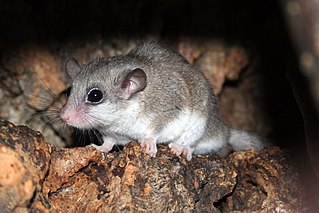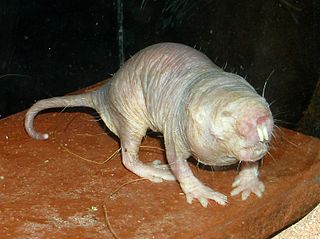
Squirrels are members of the family Sciuridae, a family that includes small or medium-sized rodents. The squirrel family includes tree squirrels, ground squirrels, and flying squirrels. Squirrels are indigenous to the Americas, Eurasia, and Africa, and were introduced by humans to Australia. The earliest known fossilized squirrels date from the Eocene epoch, and among other living rodent families, the squirrels are most closely related to the mountain beaver and to the dormice.

A dormouse is a rodent of the family Gliridae. Dormice are nocturnal animals found in Africa, Asia, and Europe. They are named for their long, dormant hibernation period of six months or longer.

Simplicidentata is a group of mammals that includes the rodents and their closest extinct relatives. The term has historically been used as an alternative to Rodentia, contrasting the rodents with their close relatives the lagomorphs. However, Simplicidentata is now defined as including all members of Glires that share a more recent common ancestor with living rodents than with living lagomorphs. Thus, Simplicidentata is a total group that is more inclusive than Rodentia, a crown group that includes all living rodents, their last common ancestor, and all its descendants. Under this definition, the loss of the second pair of upper incisors is a synapomorphic feature of Simplicidentata. The loss of the second upper premolar (P2) has also been considered as synapomorphic for Simplicidentata, but the primitive simplicidentate Sinomylus does have a P2.

Dipodoidea is a superfamily of rodents, also known as dipodoids, found across the Northern Hemisphere. This superfamily includes over 50 species among the 16 genera in 3 families. They include the jerboas, jumping mice, and birch mice. Different species are found in grassland, deserts, and forests. They are all capable of saltation, a feature that is most highly evolved in the desert-dwelling jerboas.

The rodent parvorder or infraorder Phiomorpha comprises several living and extinct families found wholly or largely in Africa. Along with Anomaluromorpha and perhaps the extinct Zegdoumyidae, it represents one of the few early colonizations of Africa by rodents.

Hystricomorpha is a term referring to families and orders of rodents which has had many definitions throughout its history. In the broadest sense, it refers to any rodent with a hystricomorphous zygomasseteric system. This includes the Hystricognathi, Ctenodactylidae, Anomaluridae, and Pedetidae. Molecular and morphological results suggest the inclusion of the Anomaluridae and Pedetidae in Hystricomorpha may be suspect. Based on Carleton & Musser 2005, these two families are discussed here as representing a distinct suborder Anomaluromorpha.
Birbalomys is an extinct genus of rodent from Asia.

Eomyidae is a family of extinct rodents from North America and Eurasia related to modern day pocket gophers and kangaroo rats. They are known from the Middle Eocene to the Late Miocene in North America and from the Late Eocene to the Pleistocene in Eurasia. Eomyids were generally small, but occasionally large, and tended to be squirrel-like in form and habits. The family includes the earliest known gliding rodent, Eomys quercyi.
Armintomys is an extinct genus of rodent from North America related to jerboas and jumping mice. It is the only genus in the family Armintomyidae. It lived during the early Eocene, and is the oldest known example of a hystricomorphous zygomasseteric dentition. In addition, Armintomys is also the oldest known rodent that had an incisor enamel transition from pauciserial to uniserial. Its remains have only been found in the Wind River Basin in Wyoming, and could be found there during the species' existence on Earth. It was previously assumed that Armintomys belonged to the Dipodoidea family, but has since been understood to have been part of an early radiation of dipodoid rodents, but was not directly ancestral to any later dipodoids, thus it was recategorized into its own family.

Ailuravus is a genus of prehistoric rodents in the family Ischyromyidae.
Gobiomyidae is a small extinct family of rodents from the Eocene of Asia. The family contains four genera and belongs to the superfamily Ctenodactyloidea, which also contains the living Laotian rock rat and gundis and their fossil relatives. When Wang named the family, gobiomyids were considered the closest known relatives of Ctenodactylidae, but newer research indicates that Diatomyidae is more closely related to living ctenodactylids.
Archetypomys is an extinct genus of early Eocene rodent and the only member of the family Archetypomyidae. A single species, Archetypomys erlianensis, has been described from Inner Mongolia. Archetypomys was a very small rodent intermediate in morphology between the basal rodent family Alagomyidae and more advanced rodents.

Tillodontia is an extinct suborder of eutherian mammals known from the Early Paleocene to Late Eocene of China, the Late Paleocene to Middle Eocene of North America where they display their maximum species diversity, the Middle Eocene of Pakistan, and the Early Eocene of Europe. Leaving no descendants, they are most closely related to the pantodonts, another extinct group. The tillodonts were medium- to large-sized animals that probably fed on roots and tubers in temperate to subtropical habitats.
The Irdin Manha Formation is a geological formation from the Eocene located in Inner Mongolia, China, a few kilometres south of the Mongolian border.
The Washakie Formation is a geologic formation in northern Colorado and southern Wyoming. It preserves many mammal, bird, reptile and other fossils dating back to the Lutetian stage of the Eocene within the Paleogene period. The sediments fall in the Bridgerian and Uintan stages of the NALMA classification.
This paleomammalogy list records new fossil mammal taxa that were described during the year 2010, as well as notes other significant paleomammalogy discoveries and events which occurred during that year.
Nanotitanops is an extinct genus of Brontothere from the middle Eocene of China. It contains a single species, N. shanghuangensis. It is known only from isolated teeth, the smallest of any known Brontothere.

Anagalidae is an extinct family of mammals closely related to rodents and lagomorphs. Members of the family are known from Paleocene to Oligocene deposits in China and Mongolia.
Astigalidae is an extinct family of mammals related to the rodents and lagomorphs. Members of the family are known from the Paleocene and Eocene of China.
Teratopithecus is an extinct genus of archaeopithecid notoungulate that lived during the Middle Eocene of what is now Argentina. Fossils of this genus have been found in the Sarmiento Formation of Argentina.









